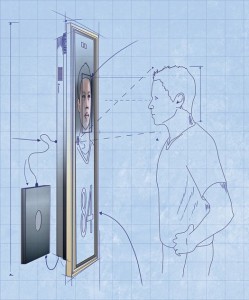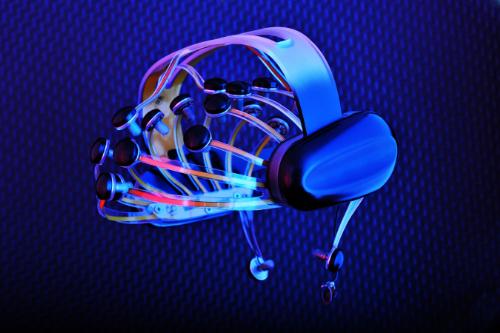The mirror on the wall may soon reveal more than your appearance, becoming a two-way mirror for advertisers

Designed by MIT student Ming-Zher Poh, the Medical Mirror uses a complex algorithm to detect vital signs through optics with a simple camera
Two years ago, MIT student Ming-Zher Poh managed to turn his laptop’s webcam into a heart rate monitor. At the time he was looking for a way for doctors to check vital signs in the least invasive way possible. The method he came up with was fairly simple: As each pump of the heart sends fresh waves of blood through your veins, the light that penetrates your skin and bounces off your muscles fluctuates subtly. When these fluctuations are analyzed by a computer and camera, they can be translated into heart-rate data.
Although the technology is not new, Poh created a new algorithm which allowed a much less sensitive standard laptop webcam to isolate the blood flow light pattern from other light collected by the camera. Using an adapted process to extract single sounds from a noisy recording, Poh, managed to cleverly tie this into a way for even a lower resolution camera to isolate data and even track multiple subjects.
So what did he do with it? He built a mirror that could look inside of you.
A webcam mounted behind a two-way mirror monitors your vitals invisibly as you gaze upon your visage, displaying your heart-rate reading. Poh imagines improving the system further to measure other vitals such as respiratory rate and blood oxygen levels.
Still years away from the market, Poh plans to bring the mirror to consumers after, he hopes, he finishes his PHD later this year. Poh remains hopeful of the devices uses saying,”This shows your inner health. Maybe as people use it, they’ll say, ‘This is part of my identity. It’s not just how I look on the outside.”
Good News Everyone
Ming-Zher Poh goes on to imagine tele-medical screening tests over a webcam or even a cell phone and hands-free vital scanning of burn patients and newborns, all of which seem like positive applications for Poh’s research.
As with all new technologies though, other possible real life applications seem darker. Although Poh is currently developing the Mirror for medical uses, it’s hard to imagine the technology staying in the box, so to speak. If all it takes is an algorithm to turn a cell phone into a medical scanner, albeit a primitive one, what is in the way of this algorithm being added quietly to all devices via standard updates? If a Doctor can access your vital signs from as little as a built-in webcam who else might want this information?
While the answer to the first question might be a difficult web of consumer-protection issues, the latter question is easy to answer.
Advertisers, marketers and corporations have already spent a fortune in the field of figuring out what we feel before we do, and the tide seems far from abating.
As the recent acquisition of NeuroFocus (a company devoted to turning neurological research into useable market data) by Nielsen (of Nielsen Ratings) shows us, advertising and market analysts are taking serious Science’s promise of conquest through measure and number.
NeuroFocus grew out of a frustration by advertisers in their inability to predict what consumers wanted. And they take this quest very seriously. Just a few months ago NeuroFocus announced it had developed the worlds first wireless EEG headset, and it runs on bluetooth.
Looking a bit like something out of the movie Strange Days, the device can capture brain activity 2,000 times per second and relay that information via that bluetooth connection to your smartphone, tablet or home computer. The device has many uses, one being a hands free ‘mouse’ controlled in one incredible TED Conference video, by mere thought. Another is watching the brain for ‘happy’ or ‘sad’ readings as you scan your digital paper or watch a commercial to then relay that information to marketers and analytics teams to offer realtime insight for advertisers.

“NeuroFocus leverages ground-breaking neuroscience and expertise to measure consumer attention, engagement and memory retention through brainwave, eye-tracking and skin conductance measurements.” The company stated in a recent press release.
With so much hardware already in place, touchscreen phones can register the force of our taps and built-in cameras are in just about everything digital these days, how long will it really be before your computer can tell when you’ve had a long day and need some soothing music or maybe suggest a new restaurant based on your subconscious reaction to a commercial you recently saw for italian food?
